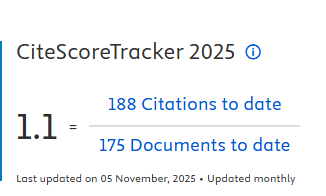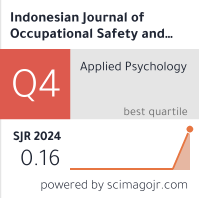Hearing Loss Risk Factors Analysis among Gold Mining Dozer Operators
Downloads
Introduction: industrial mining activities have the highest prevalence of NIHL due to operating a heavy vehicle. Dozer is one of the heavy vehicles with a high noise level. Methods: This study was descriptive research about risk factors related to hearing loss of 28 dozer operators at PT. X. The risk factors consisted of demographic factors, working behavior (listening to music, smoking), noise levels were analyzed with hearing loss using STS. Interviews were conducted with the workers and company representatives. Hearing loss examination used an audiometric test to determine the STS of the operators with the result that positive more than 10 dB and negative at 10 dB or less. All the data is secondary. Results: noise level of all dozers exceeds the TLV (>85dB) operated for 10 hours a day and six days a week. Half of the dozer operators had STS (+) occurred at age 40 years and older, working for more than five years, not use the PPE or misused, the habit of listening to music and smoking. Conclusion: noise and demographic factors can increase the risk of hearing loss in dozer operators. The company must control by combining plywood, foam, tray, and coir material in the dozer cabin, which can reduce 31.94 dB and apply for PPE double protection.
Abbasi, S. (2018) ‘Defining Safety Hazards and Risks in Mining Industry: A Case-Study in United States', Asian Journal of Applied Science and Technology (AJAST) , 2(2), pp. 1071–1078.
Abraham et al. (2019) ‘Prevalence of Noise-in-Duced Hearing Loss among Textile Industry Workers in Dar es Salaam, Tanzania', Annals of Global Health, 85(1), pp. 1–6.
ACGIH (2019) TLVs and BEIs. 2019th edn. Cinncinati.
ACGIH (2020) THRESHOLD LIMIT VALUES (TLV®). 2020th edn. Ohio.
Blackwell, Lucas and Clarke (2014) ‘Summary Health Statistics for U.S. Adults: National Health Interview Survey, 2012.', Vital Health Stat 10, 260(1), p. 161.
Carroll, Y. I., et al. (2017) ‘Vital Signs: Noise-Induced Hearing Loss Among Adults ” United States', Morbidity and Mortality Weekly Report, 66(5), pp. 139–144.
Claudia, T., Valentin, N. and Gabriel, L. (2011) ‘Actual Stage of Industrial Noise Reduction', Journal of Engineering Studies and Research, 17(4), pp. 89–95.
National Safety Council (2019) Double Hearing Protection. Itasca: National Safety Council.
Cunningham, L. L. and Tucci, D. L. (2017) ‘Hearing Loss in Adults', The New England Journal of Medicine, 377(25), pp. 2465–2473.
Dudarewicz et al. (2018) ‘Evaluation of on-the-Job Noise Exposure in the Case of Bartenders', Medycyna Pracy, 69(6), pp. 633–641.
Feder, K. et al. (2017) ‘Prevalence of Hazardous Occupational Noise Exposure, Hearing Loss, and Hearing Protection Usage among a Representative Sample of Working Canadians', Journal of Occupational and Environmental Medicine, 59(1), pp. 92–113.
Harrianto (2013) Buku Ajar Kesehatan Kerja. 1st edn. Jakarta: EGC.
Kerns, E. et al. (2018) ‘Cardiovascular Conditions, Hearing Difficulty, and Occupational Noise Exposure within US Industries and Occupations', American Journal of Industrial Medicine, 61(6), pp. 477–491.
Le, T. N. et al. (2017) ‘Current Insights in Noise-Induced Hearing Loss: A Literature Review of the Underlying Mechanism, Pathophysiology, Asymmetry, and Management Options', Journal of Otolaryngology - Head and Neck Surgery, 46(1), pp. 1–15.
Levin, J. L. et al. (2016) ‘Hearing Loss and Noise Exposure among Commercial Fishermen in the Gulf Coast', Journal of Occupational and Environmental Medicine, 58(3), pp. 306–313.
Li, X. et al. (2020) ‘Association between Smoking and Noise-Induced Hearing Loss: A meta-Analysis of Observational Studies', International Journal of Environmental Research and Public Health, 17(4), pp. 1-14.
Majidpour, A. et al. (2021) ‘Applications of Extended High-Frequency Audiometry: A Narrative Review', Auditory and Vestibular Research, 30(3), pp. 167–175.
Masterson, E. A. et al. (2016) ‘Hearing Impairment Among Noise-Exposed Workers ” United States, 2003–2012', MMWR. Morbidity and Mortality Weekly Report, 65(15), pp. 389–394.
Mayasari and Khairunnisa (2017) ‘Pencegahan Noise Induced Hearing Loss pada Pekerja Akibat Kebisingan', Jurnal Kesehatan dan Agromedicine, 4(2), pp. 354–60.
Murphy, W. J. et al. (2020) ‘National Occupational Research Agenda for Hearing Loss Prevention', Proceeding of Meetings on Acoustics, 36, pp. 1–13.
National Academies of Sciences, Engineering, and M. (2016) Hearing health care for adults: priorities for improving access and affordability. Washington DC: The National Academies Press.
Occupational Safety and Health Administration, U. D. of L. (2002) Hearing Conservation (OSHA 3074- 2002). Washington DC: Occupational Safety and Health Administration.
Minister of Manpower Regulation(2018) Peraturan Menteri Ketenagakerjaan Republik Indonesia Nomor 5 Tahun 2018 tentang Keselamatan dan Kesehatan Kerja Lingkungan Kerja. Jakarta: Minister of Manpower Regulation.
Pienkowski, M. (2017) ‘On the Etiology of Listening Difficulties in Noise Despite Clinically Normal Audiograms', Ear and Hearing, 38(2), pp. 135–148.
Ramadhani, P. N. and Firdausiana, Y. D. (2020) ‘Noise Exposure and Hearing Loss on Field Operator Compressor House Area', Jurnal Kesehatan Lingkungan, 12(2), pp. 126-135.
Saleh, S., Woskie, S. and Bello, A. (2017) ‘The Use of Noise Dampening Mats to Reduce Heavy-Equipment Noise Exposures in Construction', Safety and Health at Work, 8(2), pp. 226–230.
Septiana and Widowati (2017) ‘Gangguan Pendengaran Akibat Bising', HIGEIA: Journal of Public Health Research and Development, 1(1), pp. 73–82.
Setyawan, F. E. B. (2021) ‘Prevention of Noise Induced Hearing Loss in Worker: A Literature Review', Jurnal Kedokteran dan Kesehtan Indonesia, 12(2), pp. 182–190.
Sliwinska-Kowalska, M. and Davis, A. (2012) ‘Noise-Induced Hearing Loss', Noise and Health. 14, pp. 274-280.
ÅšliwiÅ„ska-Kowalska, M. and Zaborowski, K. (2017) ‘WHO Environmental Noise Guidelines for the European Region: A Systematic Review on Environmental Noise and Permanent Hearing Loss and Tinnitus', International Journal of Environmental Research and Public Health, 14(10)p. 1139.
Swierczek, P. D., Sochan, A. and Kornatowska, K. K. (2020) ‘Noise-Induced Hearing Loss In Children And Adolescents : A Review', Journal Hearing Science, 10(2), pp. 27–31.
Tang, X. and Yan, X. (2017a) ‘Acoustic energy absorption properties of fibrous materials: A Review', Composites: Part A, 101, pp. 360–380.
Tang, X. and Yan, X. (2017b) ‘Multi-layer Fibrous Structures for Noise Reduction', The Journal of The Textile Institute, 108(12), pp. 2096–2106.
Themann, C. L. and Masterson, E. A. (2019) ‘Occupational Noise Exposure: A Review of its Effects, Epidemiology, and Impact with Recommendations for Reducing its Burden', The Journal of the Acoustical Society of America, 146(5), pp. 3879–3905.
Themann, C., Suter, A. H. and Stephenson, M. (2013) ‘National Research Agenda for The Prevention of Occupational Hearing Loss - Part 1.', Semin Hear, 34, pp. 145–207.
Tinoco, H.C. et al. (2019) ‘Risk Perception in the Use of Personal Protective Equipment Against Noise-Induced Hearing Loss', Gestí£o & Produçí£o, 26(1), pp. e1611.
Tong, R. et al. (2019) ‘Risk Assessment of Miners' Unsafe Behaviors: A Case Study of Gas Explosion Accidents in Coal Mine, China', International Journal of Environmental Research and Public Health, 18(16), pp. 1-18
Waqas, M. et al. (2018) ‘Inner Ear Hair Cell Protection in Mammals against the Noise-Induced Cochlear Damage', Neural Plasticity, 2018(Special Issue), pp. 1-9.
Welch, D. and Fremaux, G. (2017) ‘Why do People Like Loud Sound? A Qualitative Study', International Journal of Environmental Research and Public Health, 14(8).p. 908.
Wiradewa, A., Wiyadi, H. M. S. and Dewanti, L. (2017) ‘Hubungan Paparan Kebisingan, Karakteristik Pegawai, Kepatuhan dan Pengawasan dalam Pemakaian Alat Pelindung Diri Telinga dengan Ambang Pendengaran Pegawai PT X di Kabupaten Gresik', Jurnal Ilmiah Mahasiswa Kedokteran Universiyta Airlangga, 9 (1), pp. 6–13.
World Health Organization (2015) ‘Safe listening.', Bulletin of the World Health Organization, 93(4), p. 213.
World Helath Organization (2018) Addressing The Rising Prevalence of Hearing Loss, World Health Organization: Geneva, Switzerland
Yin, H. et al. (2020) ‘Salt-Inducible Kinase 3 Haplotypes Associated with Noise-Induced Hearing Loss in Chinese Workers', Audiology and Neurotology, 2020(25).pp. 200-208.
Copyright (c) 2022 The Indonesian Journal Of Occupational Safety and Health

This work is licensed under a Creative Commons Attribution-NonCommercial-ShareAlike 4.0 International License.

In order to be accepted and published by The Indonesian Journal of Occupational Safety and Health, Author(s) who submit an article should complete all the review process. The copyright of received articles assigned to the The Indonesian Journal of Occupational Safety and Health and Department of Safety and Health, Universitas Airlangga as publishers of the journal. The intended copyright includes the rights to publish articles in various forms (including reprints).
The Editorial Team of The Indonesian Journal Of Occupational Safety and Health and Department of Safety and Health strive to ensure that no errors occur in the articles that have been published, both data errors and statements in the article.
Users of this website will be licensed to use materials from this website following the Creative Commons Attribution-NonCommercial-ShareAlike 4.0 International License. No fees charged. Please use the materials accordingly.
------------------------------------------------------------------------------------------------------------------------------------------------------------------------------------------
Attribution ” You must give appropriate credit, provide a link to the license, and indicate if changes were made. You may do so in any reasonable manner, but not in any way that suggests the licensor endorses you or your use.
NonCommercial ” You may not use the material for commercial purposes.
ShareAlike ” If you remix, transform, or build upon the material, you must distribute your contributions under the same license as the original.







 How to Submit Articles in OJS
How to Submit Articles in OJS

























